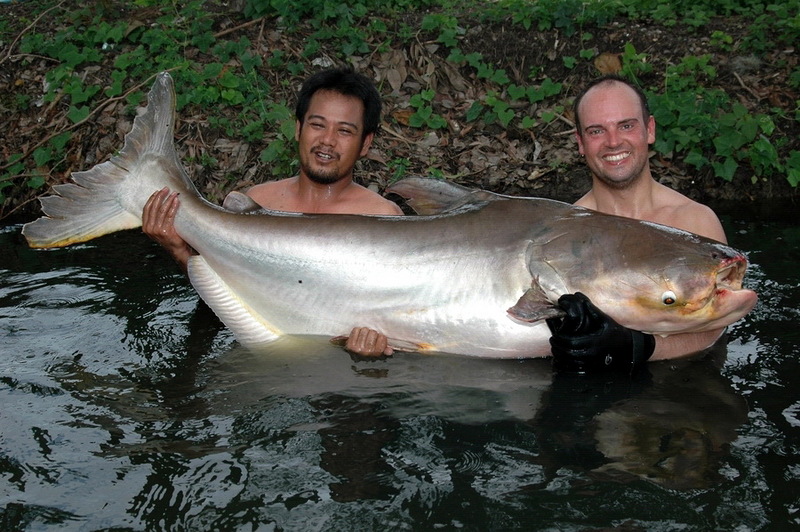|
| 질의: white catfish | 결과: 9번째/29 | |
Mekong Giant Catfish (Pangasianodon gigas) - Wiki
| 제목: | Mekong Giant Catfish (Pangasianodon gigas) - Wiki
| |

| 해상도: 900x598
파일크기: 274838 Bytes
촬영일: 2005:06:03 07:20:26
사진기: NIKON D70 (NIKON CORPORATION)
F number: f/3.5
Exposure: 10/5000 sec
Focal Length: 340/10
등록시간: 2007:09:05 23:47:25
|
Mekong giant catfish
From Wikipedia, the free encyclopedia
[Photo] Photographed by: Helias, Jean-Francois on 2005/6/3. Pangasius gigas. Image of: Claus Helveg (Denmark). Locality: Bung Sam Lan Lake, Thailand, 3 June 2005. Angler: Claus Helveg (Denmark), fish weight 64 kg. Copyright ?? Jean-Francois Helias.
The Mekong giant catfish, Pangasianodon gigas, is a species of catfish (order Siluriformes) in the shark catfish family (family Pangasiidae), native to the Mekong basin in Southeast Asia.
Taxonomy
Some sources consider P. gigas to be a member of genus Pangasius, while others classify it in Pangasianodon. This is due to the variable recognition of the level of Pangasianodon, which is sometimes recognized as a subgenus of Pangasius and sometimes as its own genus.
Conservation
Endemic to the lower half of the Mekong river, this catfish is in danger of extinction due to overfishing, as well as the decrease in water quality due to development and upstream damming. The current IUCN Red List for fishes classes the species as Critically Endangered; while the number of individuals living in the wild is not known, catch data indicate that the population has fallen by 80 percent in the last 13 years. It is also listed in Appendix I of CITES, banning international trade. Fishing for the Mekong giant catfish is illegal in Thailand, Laos, and Cambodia, but the bans appear to be ineffective, with the fish continuing to be caught in all three countries. However, in recognition of the threat to the species, nearly 60 Thai fishermen agreed to stop catching the endangered catfish in June 2006, to mark the 60th anniversary of Bhumibol Adulyadej's accession to the throne of Thailand.
Size
Attaining an unconfirmed length of 3 m, the Mekong giant catfish grows extremely quickly, reaching a mass of 150 to 200 kg in only six years. The largest catch recorded in Thailand since record-keeping began in 1981 was a female measuring 2.7 m (roughly 9 feet) in length and weighing 293 kg (646 lb). This specimen, caught in 2005, is widely recognized as the largest freshwater fish ever caught. Thai Fisheries officials stripped the fish of its eggs as part of a breeding programme, intending then to release it, but the fish died in captivity and was sold as food to local villagers.
Grey to white in colour and lacking stripes, the Mekong giant catfish is distinguished by the near-total lack of barbels and the absence of teeth.
Relationship to humans
In Laos, it is called pa beuk, and is the most highly-esteemed fish in Lao cuisine. In former times, specific rites were associated with the catch of these fish, which was conducted once yearly. Rarely is the fish available in markets. Food writer Alan Davidson describes its flesh with words like "superlative", "admirable texture and unmatched flavour", and "subtle and majestic". The liver is a delicacy and the pickled roe of the females provide "Laotian caviar".
It is also known as pla buk, pla ma fai, pla nang, or pla hua kum hang hum (Thai); c?? tra d???u (Vietnamese); and trey r??ach (Khmer).
http://en.wikipedia.org/wiki/Mekong_giant_catfish
| The text in this page is based on the copyrighted Wikipedia article shown in above URL. It is used under the GNU Free Documentation License. You may redistribute it, verbatim or modified, providing that you comply with the terms of the GFDL. |
|
^o^
동물그림창고 똑똑전화 누리집
^o^
|
|

